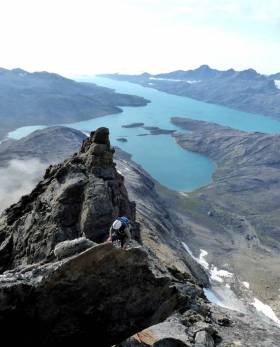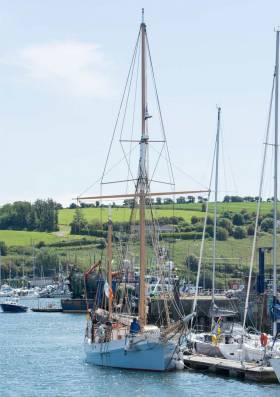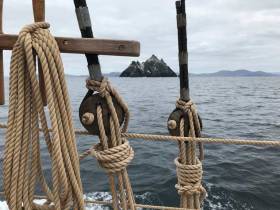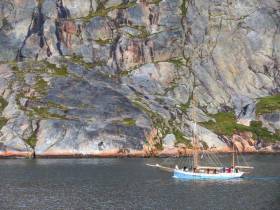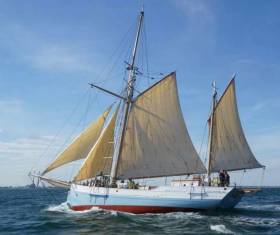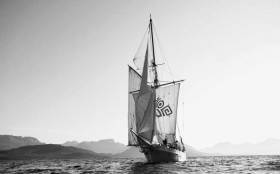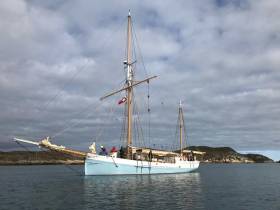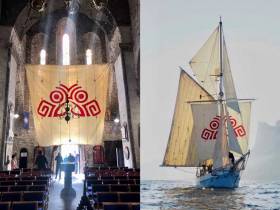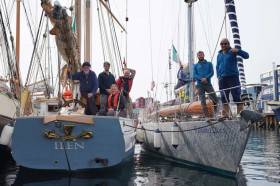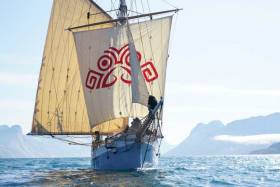Displaying items by tag: Ilen
Limerick Ketch Ilen’s 'Salmon's Wake' Voyage to Greenland Provided Research from High Latitudes
This past summer’s successful Salmon’s Wake voyage by Limerick’s 56t traditional ketch Ilen to Greenland worked productively in many ways in high mountains, on the sea, and in ports where the crew interacted with Greenlanders on several cultural programmes.
But for Project Manager and skipper for the outward voyage Gary Mac Mahon, a particular aspect of Ilen’s fascinatingly varied sailing across oceans, along the coast of Greenland, and off the coast of Ireland, is that it has been done in a trading ketch of traditional Irish type, the only one currently sailing.
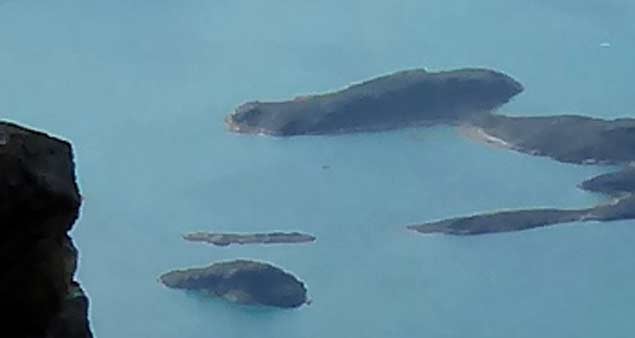 Seen from the heights of Tilman Peak, Ilen is the distant dot barely perceptible at the centre of this image. Photo: Paddy O’Brien
Seen from the heights of Tilman Peak, Ilen is the distant dot barely perceptible at the centre of this image. Photo: Paddy O’Brien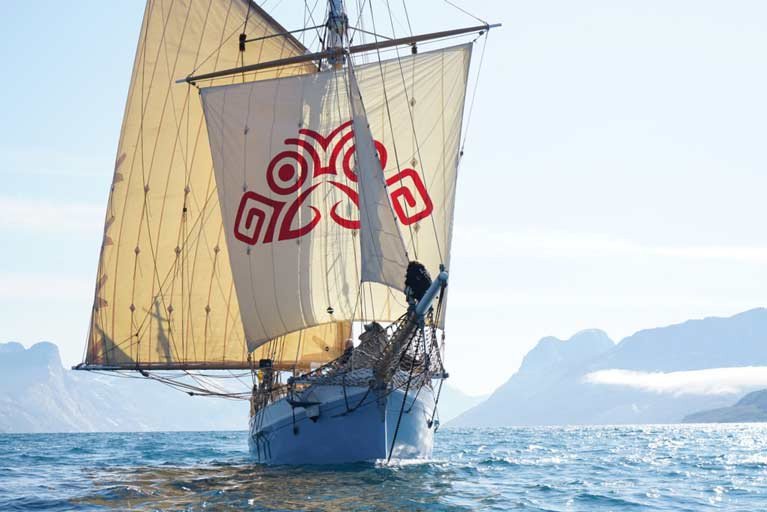 An “obsolete” yet still relevant type – the 1926 ketch Ilen in Greenland in 2019, setting her traditional square sail complete with distinctive Salmons Wake logo. Photo: Gary Mac Mahon
An “obsolete” yet still relevant type – the 1926 ketch Ilen in Greenland in 2019, setting her traditional square sail complete with distinctive Salmons Wake logo. Photo: Gary Mac Mahon
Here he reflects on this aspect of Ilen’s busy year, and makes links to previous sailors of “obsolete” craft:
SALMONS WAKE, 2019
“Let past times become pastimes”- James Joyce, Finnegans Wake, (1939)
“The venturesome pastime of sailing relatively small obsolete wooden traditional vessels towards remote parts in the pursuit of climbing, or just communing with lonely coastal mountains, is very much the business of a small group of individuals writes Gary Mac Mahon.
These individuals were favoured or perhaps inflicted with a singular character, and while often perceived misanthropically, were rather just the individual expression of an inscrutable humanity.
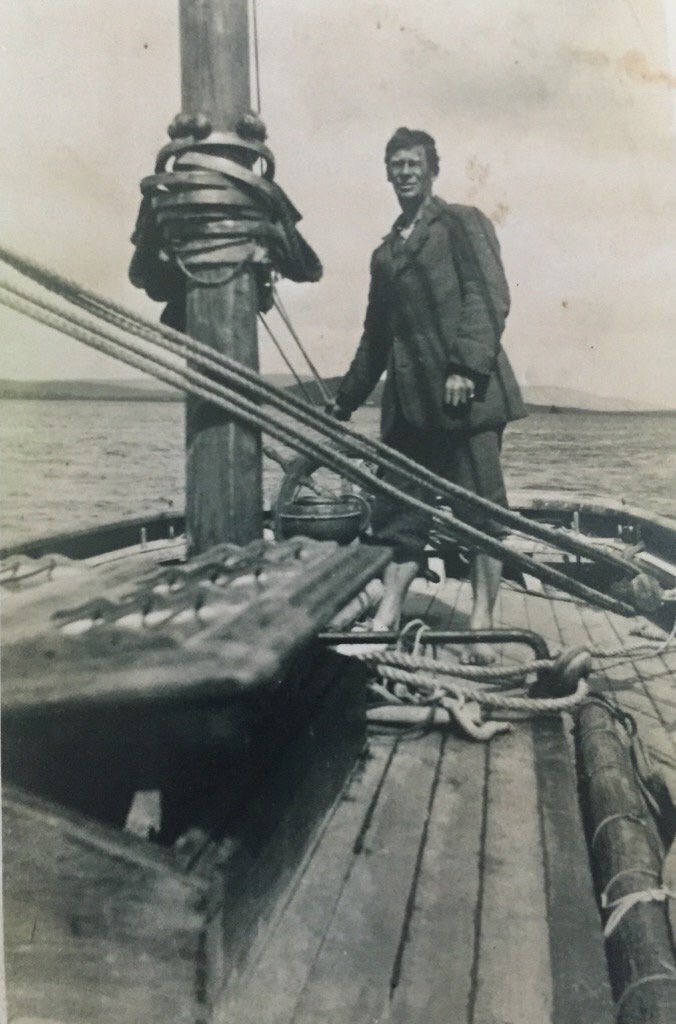
For this piece reflecting on the origins of the Ilen Project, I have plucked out two from a very small group, and they are mountaineer and round-the-world voyaging pioneer Conor O’Brien of Foynes (b.1880), and mountaineer/sailor Bill Tilman (who latterly lived in the mountains in North Wales, b.1898). Both were men of extraordinary fortitude and energy who shared a rich capacity for writing, ocean voyaging, mountaineering and the maintaining of big timbered sailing boats.
Both these men seemed at variance with the epoch they were inescapably thrust into, exemplified by their singular and similar life choices, but specifically for this specialized role: the nostalgic retrieval of boat forms of times past for deployment in the pursuit of adventurous pastimes. A not uncommon if atavistic response from individuals in the face of a world which would otherwise change too fast.”
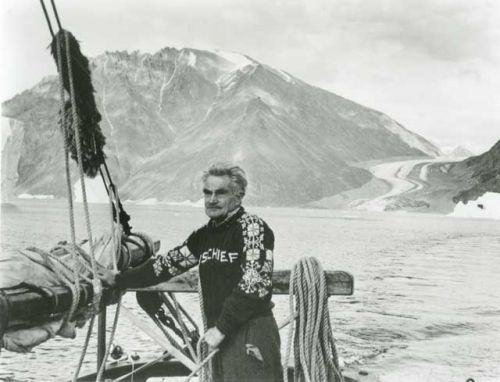
Limerick Ketch Ilen Safely Back to Ireland with Berth in Kinsale
The Limerick ketch Ilen returned safely from Greenland to berth at an Irish quayside for the first time in more than two months when, at 0400hrs this morning, skipper Paddy Barry and his crew brought the 56ft 1926-built “little ship” safely alongside the facilities beside the Trident Hotel in Kinsale writes W M Nixon. This will be Ilen’s base for the Autumn as – with command now passing to James Lyons - she works with the Sailing into Wellness Programme and sail-training projects with trainees from the Ilen Boat-building School in Limerick.
2019 has been an achievement-filled and extraordinary busy year for the much-loved restored vessel, for in addition to sail training courses earlier in this, her first full season, she has now completed a voyage of around 5,000 miles to and from Greenland, a voyage which included extensive intercultural and educational exchanges with the people of that enormous Arctic island.
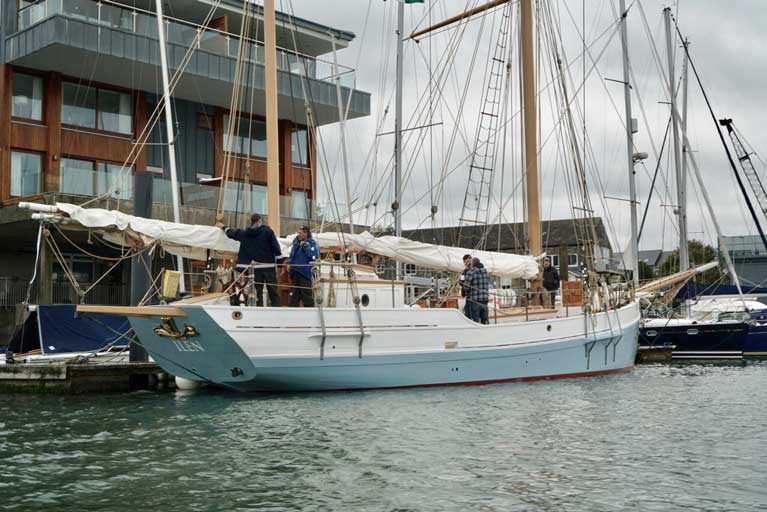 Ilen alongside at the Trident hotel in Kinsale
Ilen alongside at the Trident hotel in Kinsale
Ilen Project Director Gary Mac Mahon of Limerick and his supportive colleagues and donors deserve every congratulation for the achievements of all involved, while Ilen’s current crew in particular deserve special credit for the skilled way in which they chose the optimal weather window in which to return across the ocean at an unceasingly difficult time in the Atlantic weather cycle, for even as they were relaxing on finally being secured in Kinsale this morning, the weather was already deteriorating rapidly in the open Atlantic west of Mizen Head.
With such a busy ongoing programme, there’s scarcely time to take stock before moving into the next stage - the training programmes operating from Kinsale. But the word is that later today, most if not all of the 26 different people who were involved in getting Ilen to and from Greenland, together with extensive coastal exploration of the southwest and west Greenland coasts, will be gathering in Kinsale later today for some well-earned celebration.
Limerick Ketch Ilen Passing Skelligs – She's Due in Kinsale at 0400 Hrs Tomorrow (Wednesday)
When Conor O’Brien returned from his round the world voyage in Saoirse to Dun Laoghaire in 1925, it was all carefully choreographed so that he arrived in the middle of a Saturday afternoon, and the DBSC fleet, having abandoned their racing in his honour, were thus able to provide an escort as Saoirse came into port writes W M Nixon
But it looks as though there’ll be no fancy frippery of that sort when the Conor O’Brien-designed 1926-bult 56ft restored ketch Ilen of Limerick arrives in Kinsale tomorrow morning, fresh back from Greenland after a very successful double Transatlantic voyage. The word is that Ilen is currently close west of the Skelligs in mist and a good westerly breeze, and she's due in Kinsale at 0400 hours tomorrow (Wednesday).
It may not be everyone’s favourites time of day. But some of the crew have been away from Ireland for a very long time, and the links of home are calling them in, regardless of the selfish temporary convenience of others.
Ilen Voyage Promotes Transatlantic Learning Links for School Kids in Ireland & Greenland
There’ll be opportunities in Limerick and Greenland for young people to learn more of what the two Transatlantic voyages – outward and return - of the 56ft traditional ketch Ilen have discovered and explained, with schools now resumed after the summer break writes W M Nixon.
Several schools in the Limerick area and around Nuuk in Greenland were following the Salmons Wake voyage project, and three in particular – Thomond National School and Thomond Community College in Limerick, and Ukaliusaq Skole in Nuuk – were actively engaged in the exchange of information and personal interest by several means of communication, in addition to creating voyage-related material and artefacts.
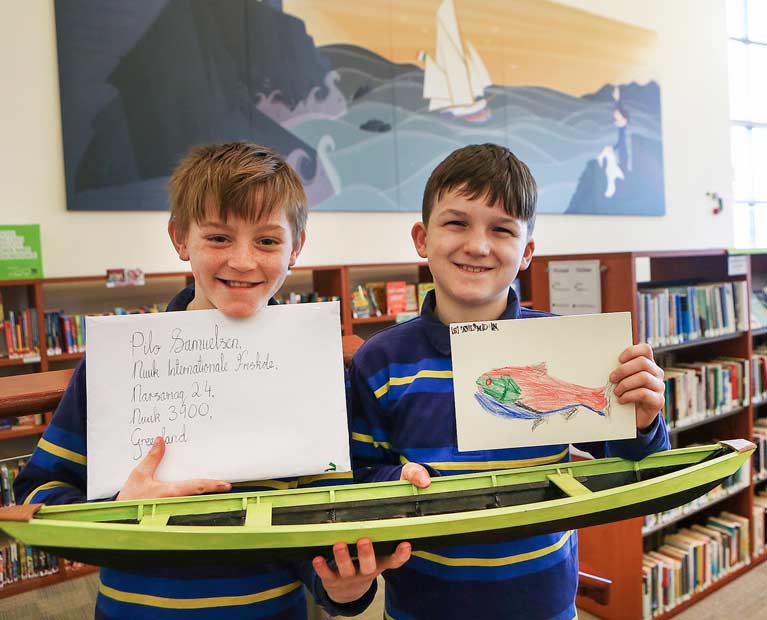 The process develops – pupils at Thomond National School with a model of the traditional Limerick Salmon Cot and letters about to be posted to Greenland
The process develops – pupils at Thomond National School with a model of the traditional Limerick Salmon Cot and letters about to be posted to Greenland
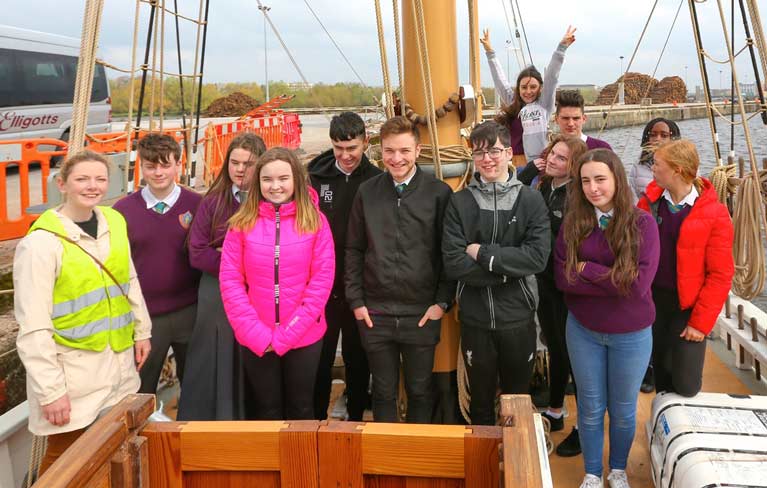 Students from Thomond Community College aboard Ilen in the dock in Limerick before she departed on her Transatlantic voyage towards Greenland.
Students from Thomond Community College aboard Ilen in the dock in Limerick before she departed on her Transatlantic voyage towards Greenland.
Supported by a Creative Ireland – Made in Limerick Grant 2018-2019, this international inter-linking was organised by Deirdre Power, Limerick Arts Co-Ordinator and Ilen Project Facilitator, and both she and artist Chelsea Canavan, the Education & Outreach Assistant at Limerick’s renowned Hunt Museum, were already in Nuuk to greet Ilen when the ketch arrived from Ireland under command of Ilen Project Director Gary Mac Mahon for the outward voyage.
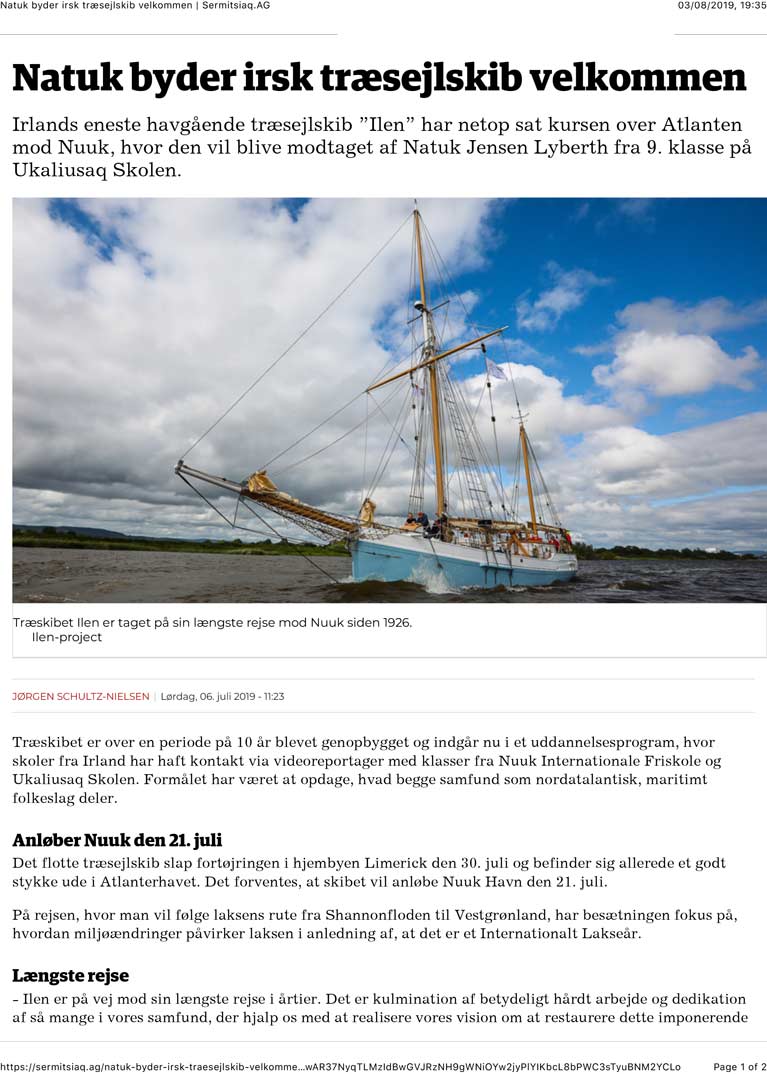 Welcome to Greenland, welcome to Nuuk – the local news outlet made much of Ilen’s arrival
Welcome to Greenland, welcome to Nuuk – the local news outlet made much of Ilen’s arrival
All were busy in Nuuk explaining aspects of the project, meeting the schools, being welcomed by the locals news outlets, making presentations and introducing the students and teachers to the real star of the show, the restored Ilen herself, which was conspicuous in Nuul harbour thanks to her traditional appearance amongst mostly very modern working craft.
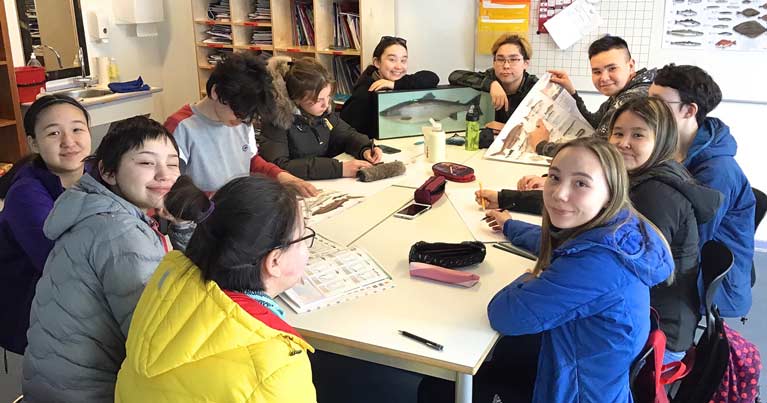 School pupils in Greenland working on their Salmons Wake response
School pupils in Greenland working on their Salmons Wake response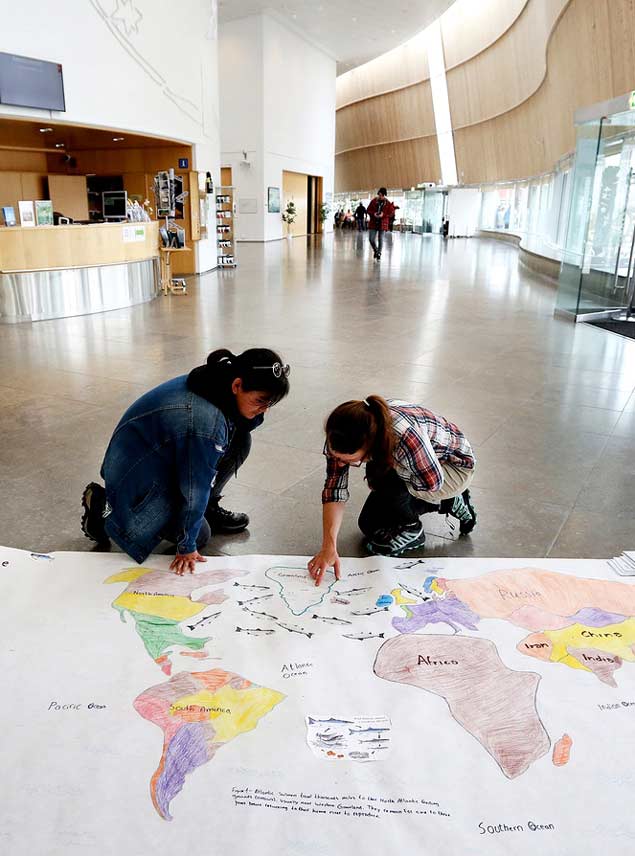 Students of Ukaliusaq School at the Katuaq Cultural Centre in Nuuk with their map of the Salmons Wake, a map which is now on display at the Watch House Cross Library in Limerick
Students of Ukaliusaq School at the Katuaq Cultural Centre in Nuuk with their map of the Salmons Wake, a map which is now on display at the Watch House Cross Library in Limerick
As to the beneficial effect this was having on the students taking part, Bernie O'Driscoll the STEM Co-Ordinator at Thomond Community College in Limerick summed it up for those in Ilen’s home port:
“Both the students and teachers involved in this captivating Salmons Wake Project have thoroughly enjoyed learning about the traditional boat building techniques used in Limerick and lamenting the unfortunate decline of the Salmon in these parts over the years. It’s been an exciting and invaluable learning experience for all involved, and we look forward to continuing the relationship established with Hanne Pederson (Teacher) and the students at Ukaliusaq Skole in Nuuk, Greenland for future years to come.”
On the Greenland side, Hanne Pedersen, a teacher with Ukaliusaq School at Nuuk, summed it up:
“My students are 14 years old, turning 15. Their main language is Greenlandic and some Danish. We are interested in the Salmons’ Wake project and follow the Ilen voyage, and participating with the Limerick students has been great!”
A sculptural representation, literally of the bare bones of a traditional Limerick salmon fishing cot, is now on display in the Old Town in Nuuk, while at the harbour during their time there, Ilen’s crew entertained other seafarers and maritime workers who were keen to see their ship, particularly the local salmon fishermen.
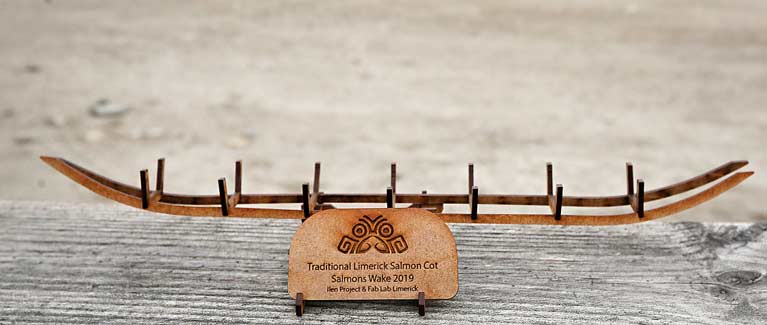 A sculpture of the bare bones of a traditional Limerick salmon cot is now on display in the Old Town in Nuuk.
A sculpture of the bare bones of a traditional Limerick salmon cot is now on display in the Old Town in Nuuk.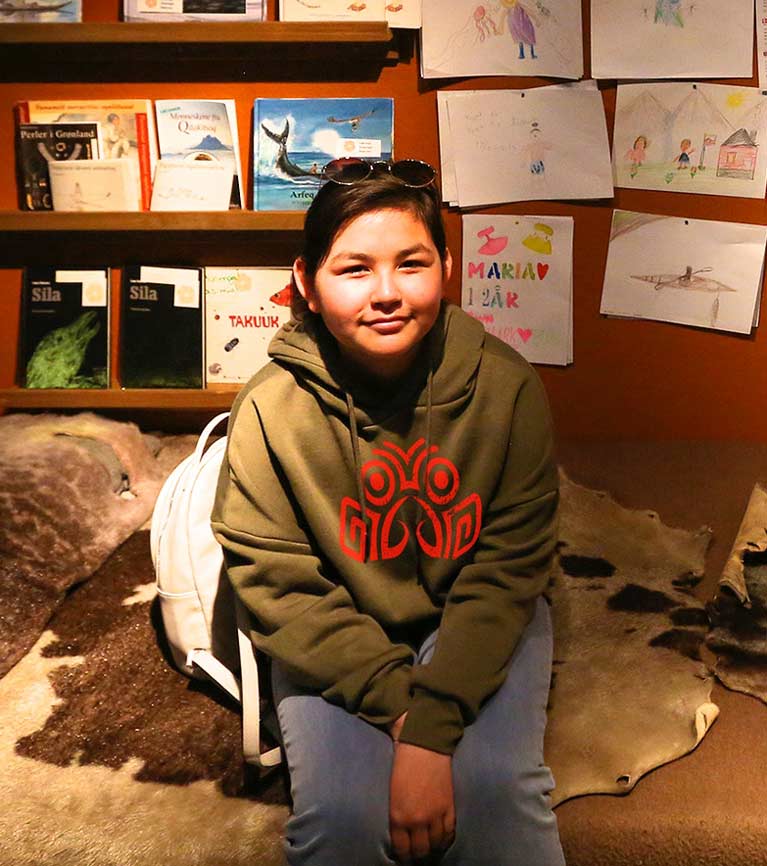 Natuk J Lyberth, a student at Ukaliusaq School, in the Archives Section of the Greenland National Museum in Nuuk wearing the distinctive Salmons Wake logo
Natuk J Lyberth, a student at Ukaliusaq School, in the Archives Section of the Greenland National Museum in Nuuk wearing the distinctive Salmons Wake logo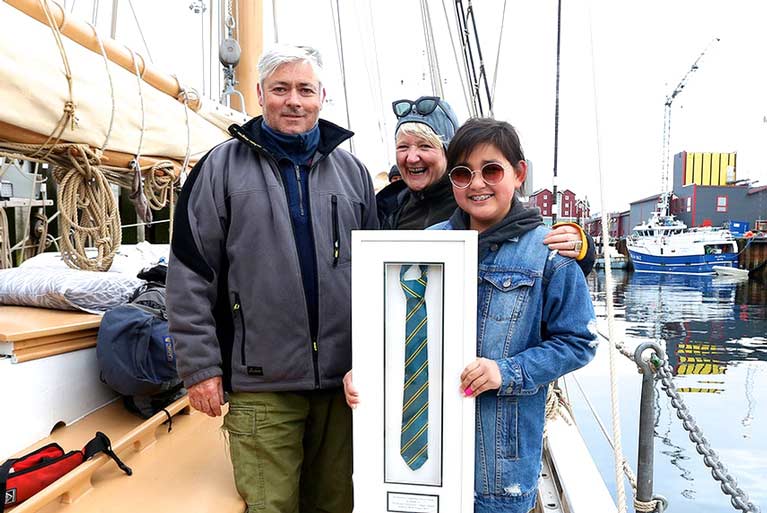 The ultimate link…..Gary Mac Mahon, Deirdre Power and Natuk Lyberth aboard Ilen in Nuuk for a presentation of the Thomond Community College neck-tie.
The ultimate link…..Gary Mac Mahon, Deirdre Power and Natuk Lyberth aboard Ilen in Nuuk for a presentation of the Thomond Community College neck-tie.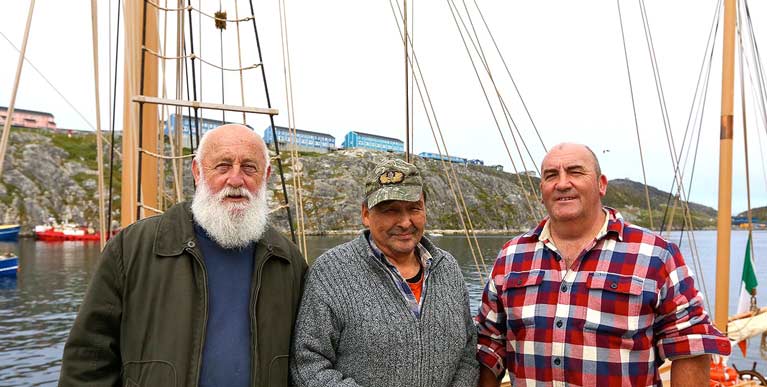 With Ilen in Nuuk are (left to right) Liam O’Donoghue of the Ilen Project, a Greenland salmon fisherman, and Mike Grimes, a member of one of Limerick’s longest-established salmon-fishing families
With Ilen in Nuuk are (left to right) Liam O’Donoghue of the Ilen Project, a Greenland salmon fisherman, and Mike Grimes, a member of one of Limerick’s longest-established salmon-fishing families
Having done so much while she was in Greenland, Ilen is now approaching Ireland and well on her way to her Autumn location in Kinsale under the command of Paddy Barry. He brought the ship through Prinz Christian Sund at the south end of Greenland, and was then poised to take advantage of a favourable developing weather pattern for the homeward passage, a matter of experienced judgment and assessment of information, for at this time of the year the always difficult-to-predict Atlantic can be in a particularly volatile mood.
The Autumn period in Kinsale for a month and more will be used by Ilen under the command of James Lyons (who is on the homeward crew) for courses with the Sailing Into Wellness programme, as well as teaching sailing to trainees with the Ilen Boat-building Project, with Ilen eventually returning to Limerick in October. For now, this brief vid gives an idea of some of the favourable weather enjoyed by Ilen on the return voyage:
To be enveloped, on the face of the deep, in northern mists for consecutive days with little or no nighttime darkness, gradually breaks one out from that familiar time and space, the ones we everyday surrender to whilst living with land. pic.twitter.com/HrOs4cMsNL
— Ilen Project (@ilenproject) September 1, 2019
Meanwhile, co-ordinator Deirdre Power is deservedly pleased with the way this very unusual concept has developed in practice, and she concludes:
“The schools, and more importantly the students, take ownership of the project, which I think is very important. The participation and collaboration may be manifested in a simple gesture, such one student from
a community in Nuuk, Greenland writing a ‘real’ letter to another student living across the North Atlantic in Limerick city, Ireland.
This is something that would never happen without this other broader spectrum. I believe the process is the most exciting element, the tangible connection between the schools, through the both the programme and respective cultures, in a way that something such as social media cannot transcend. And the tangible presence of Ilen – first in Limerick and then in Nuuk – gives it an extra and deeply-felt meaning. It remains a wonderful experience for all involved at every level”.
Limerick Ketch Ilen is Now Halfway Home to Ireland from Greenland & Headed for Kinsale
The 56ft traditional ketch Ilen under the command of Paddy Barry has been making excellent progress since departing Greenland on Sunday evening, and is already halfway home to Ireland along the 1200 mile passage from Prince Christian Sund writes W M Nixon. Fair winds have kept her steadily on her way, and the stylishly-decorated squaresail with its Salmons Wake logo has been earning its keep in maintaining comfortable yet efficient downwind progress.
Back in the early stages of the Greenland project, it had been expected that Ilen would not see Ireland again until around 10th September. But the 1926 Conor O’Brien of Limerick-designed and Baltimore-built ship has been going so well that an extra dimension has been added to the programme, and now she will head straight for Kinsale and be based there for September, fulfilling courses with the Sailing into Wellness movement, and implementing sailing teaching with her own Ilen Boat-building School trainees.
All being well, Ilen will be arriving in Kinsale in the latter half of next week.
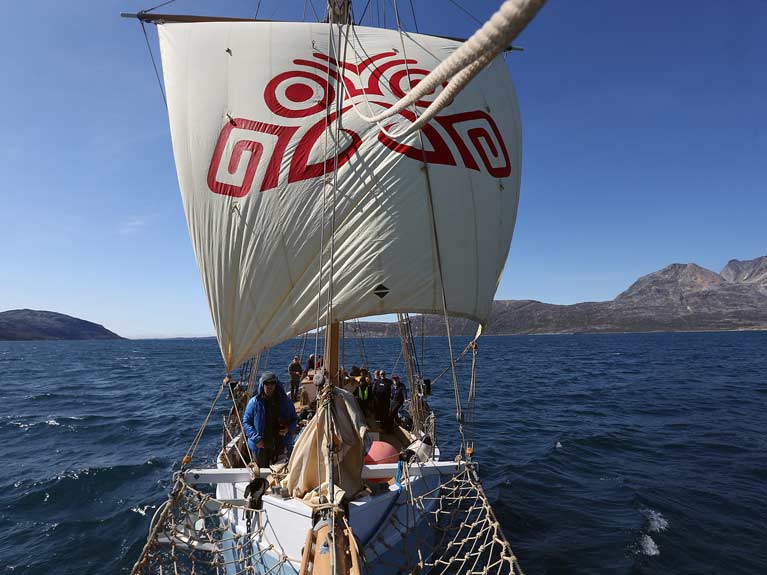 Ilen’s squaresail in action in one of south Greenland's many steep-sided channels. The squaresail has been exceptionally useful in the current downwind conditions in mid-Atlantic, sailing home to Ireland.
Ilen’s squaresail in action in one of south Greenland's many steep-sided channels. The squaresail has been exceptionally useful in the current downwind conditions in mid-Atlantic, sailing home to Ireland.
Historic Ketch Ilen Takes her Departure from Greenland, Bound for Ireland & Limerick
Limerick’s restored 56ft Conor O’Brien-designed 1926-built traditionally-rigged trading ketch Ilen emerged yesteray evening (Sunday) from the eastern end of Prince Christian Sound to start her passage back to Ireland writes W M Nixon. The magnificent Sound - noted for its dramatic scenery - leads inside the archipelago of steep islands which culminate in Greenland’s most southerly headland of Cape Farewell. By negotiating it safely, the crew of Ilen - under the command of Paddy Barry with traditional west of Ireland boat sailors Jarlath Cunnane and Dr Mick Brogan added to the strength for the return voyage - have brought themselves within 12000 miles of Loop Head and a homecoming in the Shannon Estuary.
While coast-hopping south from the Greenland capital of Nuuk, Ilen’s home-coming crew have learned more about the ship’s handling characteristics, and a favourable wind through some channels has demonstrated how effectively the square-sail – complete with its Salmons Wake logo highlighting the central theme of the voyage – can be conveniently deployed on its own when dead-running, thereby avoiding the challenges of using the heavily-boomed mainsail with its hazards when gybing in stronger and often gusty winds.
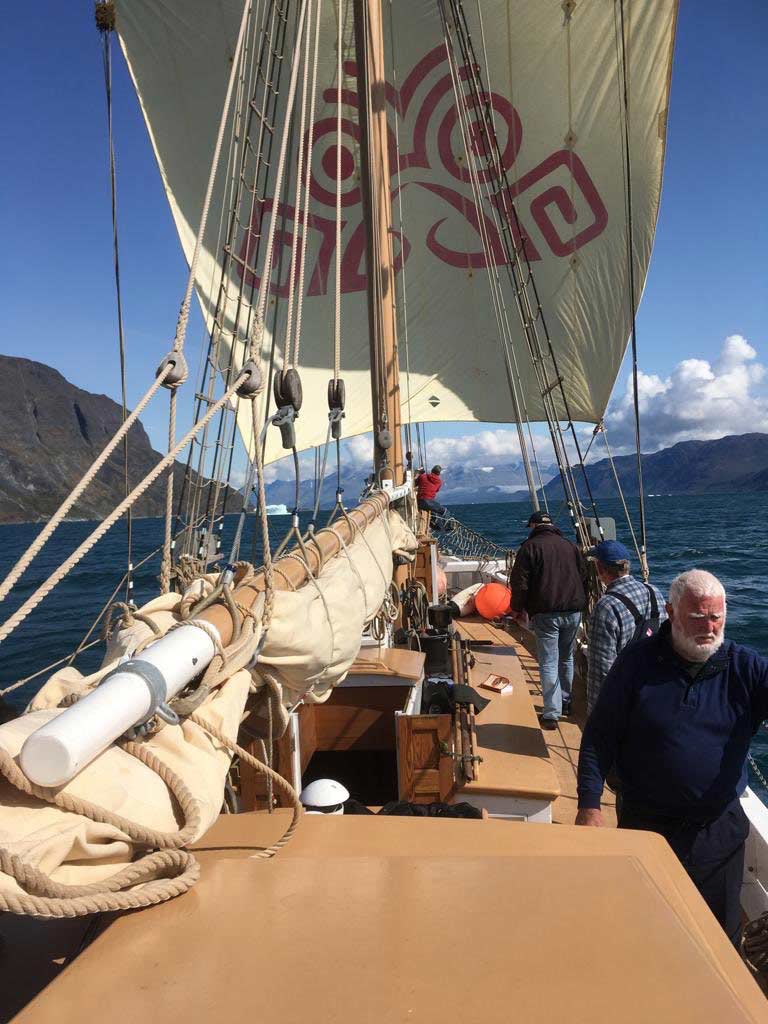 Running free without the hassle of gybing a heavy-boomed mainsail – Ilen heads comfortably under square-sail into a Greenland channel, Jarlath Cunnane on right.
Running free without the hassle of gybing a heavy-boomed mainsail – Ilen heads comfortably under square-sail into a Greenland channel, Jarlath Cunnane on right.
The crew have taken the opportunity to avail of natural hot spring baths when they’ve been anchored near one, while every option has been taken to get the vessel in compact ocean-going condition and add to ship’s stores to ensure a well-fed homeward passage. The forecast for the coming days in the area of the North Atlantic where Ilen will be voyaging is currently looking quite favourable in terms of wind directions and strength, and the ship and her crew’s many followers worldwide wish her Bon Voyage.
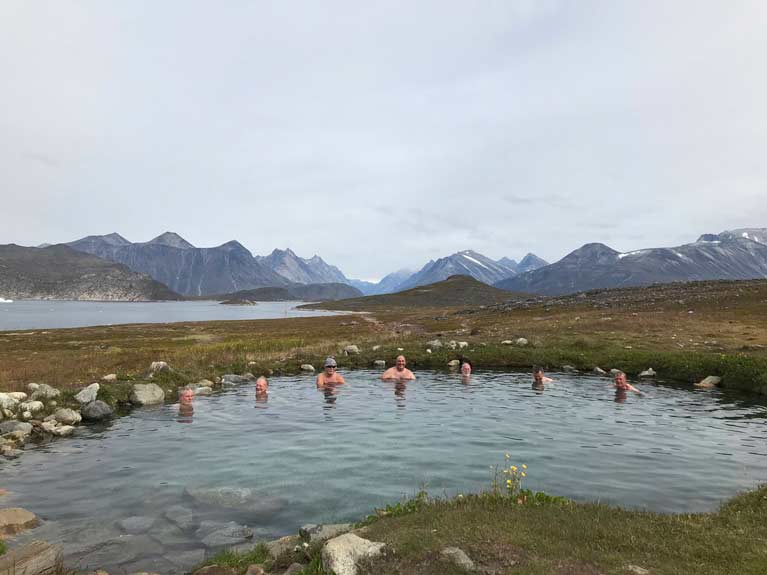 The cleanest clean they’ve ever been……..Ilen’s crew making good use of one of Greenland’s natural hot spring pools. Photo: Mantas Seskauskis
The cleanest clean they’ve ever been……..Ilen’s crew making good use of one of Greenland’s natural hot spring pools. Photo: Mantas Seskauskis
The traditional restored 56ft trading ketch Ilen of Limerick, under the command of Paddy Barry, is serenely continuing her progress homewards along Greenland’s southwest coast despite that rugged and sparsely-populated coastline suddenly becoming global news, thanks to the revelation that US President Trump views it as a strategic and highly-desirable mineral-rich piece of real estate writes W M Nixon.
While being the world’s largest island, Greenland has a population of only 58,000 who are reliant on Denmark to maintain their independent semi-autonomous position. With inter-cultural visits to many ports large and small - including the Greenland capital of Nuuk - while continuing to conduct the Salmons Wake research programme on the migratory routes of the Atlantic salmon which is so closely linked to Limerick’s own River Shannon, the crew of Ilen have come to have a keen appreciation of the Greenlanders’ perception of themselves as an independent people.
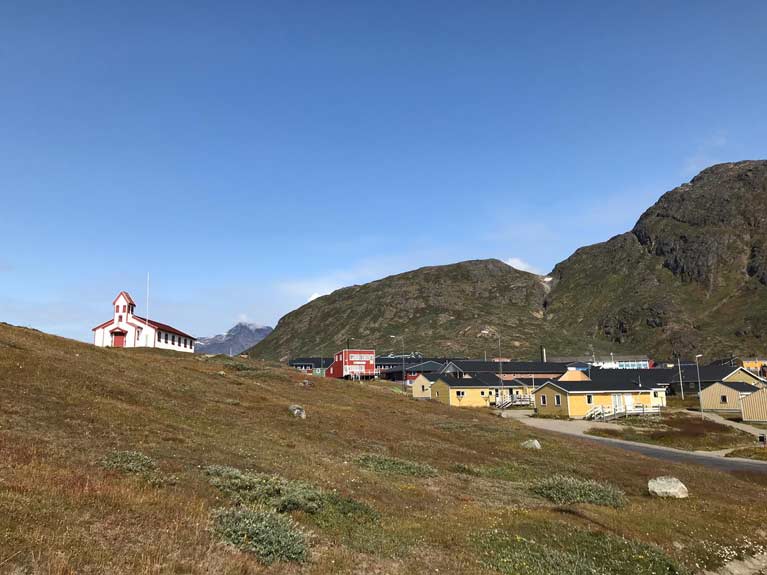 Pure Greenland – Narsaq in southwest Greenland with its tidy church and colourful buildings is a classic small Greenland community set in a big landscape which, at this time of year, has very little evidence of snow.
Pure Greenland – Narsaq in southwest Greenland with its tidy church and colourful buildings is a classic small Greenland community set in a big landscape which, at this time of year, has very little evidence of snow.
Thus they well understood the dismissive reaction by Greenlanders and Denmark alike in rejecting President Trump’s exploration of a purchase offer this week, a rejection which has caused a diplomatic spat, and the cancellation of a planned State Visit by the US President to Denmark in two weeks’ time. But this is all in the realms of international geo-politic. Ilen and her crew meanwhile have to continue with the day-to-day requirements of positioning themselves near Greenland’s southern headland of Cape Farewell in preparation for their concluding 1200 mile voyage across open Atlantic, back to the Shannon Estuary and home to Limerick.
Limerick’s Ilen is Now Homeward Bound from Greenland
The 1926-built restored 56ft Limerick trading ketch Ilen has completed the varied shoreside and coastal aspects of her research voyage to Greenland writes W M Nixon. This took her as far north as Ilulissat beyond the Arctic Circle to give first-hand experience of waters frequented by the Atlantic salmon and other wildlife, while also showing her crew the unmistakable effects of global warming.
Having returned south to the capital of Nuuk, homeward voyage skipper Paddy Barry and his shipmates have now been joined by noted west of Ireland traditional sailors Jarlath Cunnane and Dr Mick Brogan, the latter arriving onboard only a day or two after he had pulled down the shutter on the successful 40th Anniversary of Cruinniu na mBad at Kinvara, of which he is Organising Chairman.
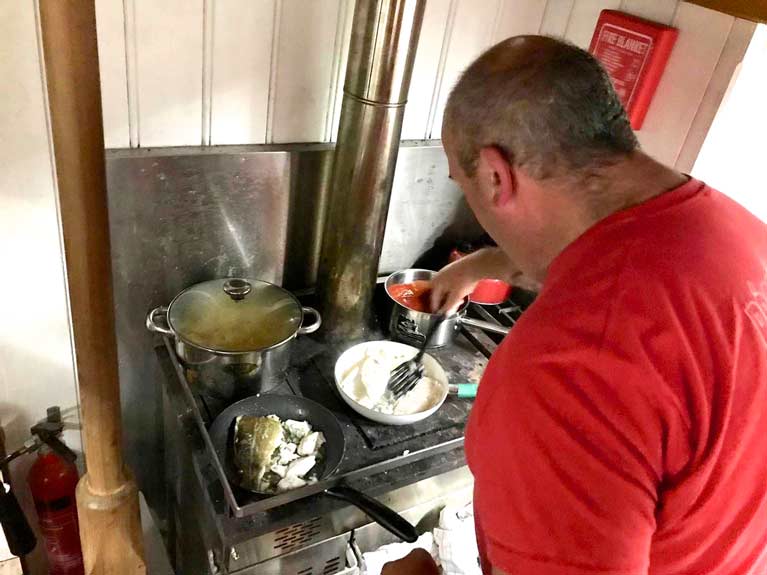 The heart of the ship. Limerick salmon fisherman Mike Grimes of Ilen’s crew “is always busy”, and here he is at the eternally warm ship’s stove with a big fish feed on the way.
The heart of the ship. Limerick salmon fisherman Mike Grimes of Ilen’s crew “is always busy”, and here he is at the eternally warm ship’s stove with a big fish feed on the way.
The primary objective now is to get Ilen safely down Greenland’s southwest coast to Cape Farewell, in order to be positioned for a return date in Limerick around September 10th. From Cape Farewell it is 1,200 sea miles across the open Atlantic to Loop Head at the entrance to the Shannon Estuary, and the Atlantic is currently in a restless mood.
But despite the primacy of the overall schedule, there was time for a bit of relaxation when the two new crewmembers from Ireland came on board, as those who have been with the ship since she sailed ocean-wards past Loop Head on July 1st were celebrating being 50 days on the project. There was also a suspicion that it might be Jarlath’s birthday. But being a Mayo man who doesn’t take much notice of such things – particularly when there are so many of them – he had to check it out on his Smartphone.
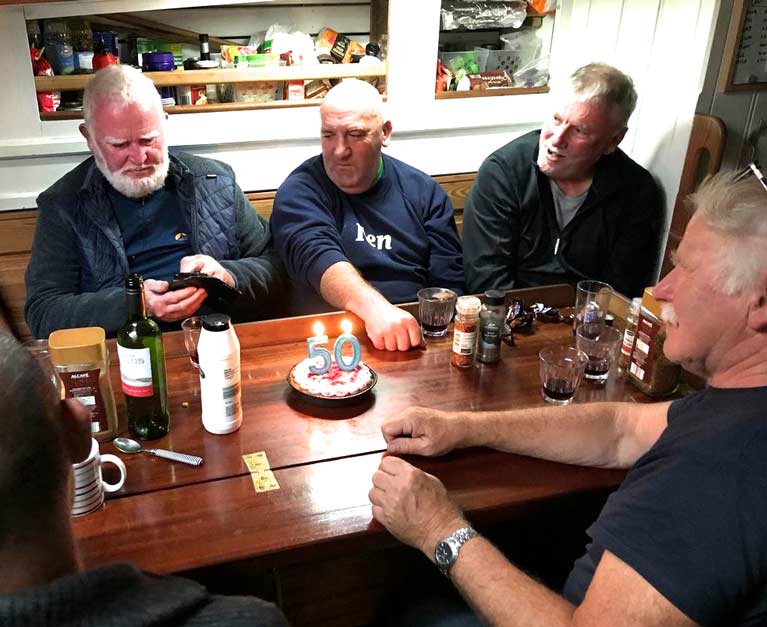 Party time when the new crewmembers arrive in Greenland. Ilen was celebrating 50 days on the voyage, and Jarlath Cunnane (left) thought it might just be his birthday too, but had to check it on his phone with (left to right) Mike Grimes, Justin McDonagh, and Cruinniu na mBad’s Dr Mick Brogan
Party time when the new crewmembers arrive in Greenland. Ilen was celebrating 50 days on the voyage, and Jarlath Cunnane (left) thought it might just be his birthday too, but had to check it on his phone with (left to right) Mike Grimes, Justin McDonagh, and Cruinniu na mBad’s Dr Mick Brogan
Greenland-Bound Irish Yachts Returning South
When Irish mountaineer Frank Nugent hiked to the top of a Greenland ice cap last week, he was shocked to observe the extent of the thaw writes Lorna Siggins.
Nugent, who has been to Greenland before, observed rapidly melting ice and snow on the summit of the Disko island ice cap, which is known as one of the top “ice” destinations in Greenland.
Greenland’s once mile-thick ice sheet began melting in the mid 19th century, but scientists reported late last year in the journal Nature that the rate has accelerated by 50 per cent since the start of the industrial era – and 30 per cent since the 20th century alone.
Nugent has been observing the impact at first hand as a member of the crew of the 17m (56 ft) Ilen, Ireland’s oldest sail trading ketch which set sail for Greenland earlier this summer.
The Ilen, now en route home to Ireland, is one of two Irish yachts which have been north of the Arctic Circle and visiting west Greenland coast communities over the past few weeks.
The 15m aluminium Killary Flyer, skippered by Irish adventurer Jamie Young, set sail from the Killary fjord on the Galway-Mayo border in early June as part of a two-year Dutch-Irish film project to document the impact of climate change.
“It is clear from talking to anyone here that the country is adapting to massive changes environmentally, socially and in their drive for independence,” film-maker/sailor Vincent Monahan of Duck Upon Rock productions, who is on board Killary Flyer, says.
While there is a serious concern, there is also “generally a positive outlook as people look for solutions”, he notes.
Since leaving Ireland on June 1st, the Killary Flyer has sailed well over 3,000 nautical miles, visiting towns, villages, outposts, and fjords up as far north as Disko Bay,” Monahan says.
Highlights included tracking humpback whales in the ice fjord at Illulisat on western Greenland, while the crew also witnessed calving glaciers at the end of the 20 nautical mile-long Evighedsfjord, Monahan says.
“The true highlight was simply the people of Greenland,” Monahan says, and their determination to maintain a strong connection with their natural environment.
Coincidentally, the crews of the Ilen and Killary Flyer met each other in mid-July in the Greenland capital of Nuuk.
The crew of the Killary Flyer were “queuing for a Danish pastry” when some lilting Irish accents began drifting across the canteen as the Ilen crew trickled in”, Monahan recalls.
The Killary Flyer crew were struck by how “immaculately restored” the Ilen, built by round-world sailor Conor O’Brien almost a century ago, looks.
“It was quite special having the two Irish boats together in Greenland side by side,” Monahan says.
Limerick Ketch Ilen - Her Work in Greenland Completed – Will Soon be Heading Home for Ireland
The traditional 56ft Limerick trading ketch Ilen will shortly begin her long return voyage from west Greenland to the Shannon Estuary, following the successful completion of the several strands of research and exploration in the Ilen Project’s Salmons Wake programme writes W M Nixon.
After departing from Ireland at Loop Head through some rough coastal conditions on July 1st, the main section of the Atlantic crossing was relatively smooth, but a local area of distinctly rugged weather made the outward passage round Greenland’s most southerly headland of Cape Farewell a real challenge.
It was successfully put astern through 30 hours of very tough going, and after calling at and interacting with several small communities along the southwest coast while continuing the Salmons Wake research, Ilen arrived safely in the Greenland capital of Nuuk in a favourable if cold and strong southerly wind.
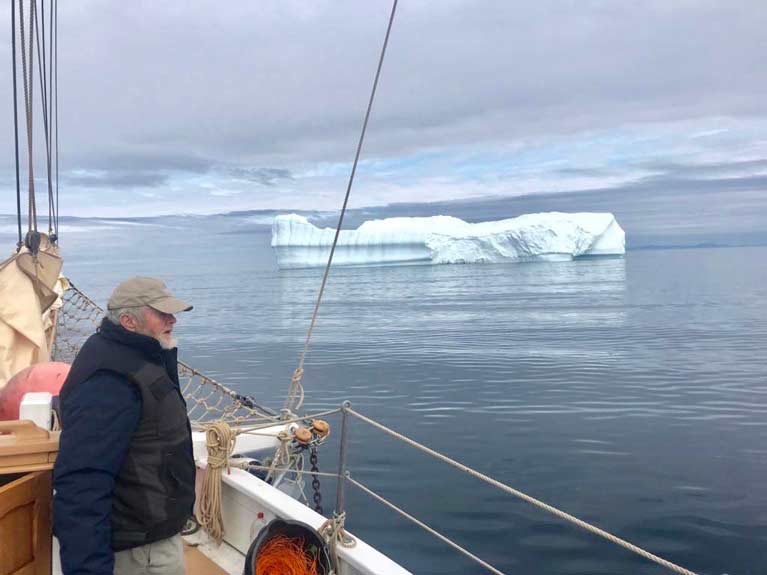 A moment for spiritual thought – aboard Ilen at the Arctic Circle with Brother Anthony Keane of Glenstal Abbey, a Director of the Ilen Project since its inception, reflecting on all that has been achieved. Photo: Deirdre Power
A moment for spiritual thought – aboard Ilen at the Arctic Circle with Brother Anthony Keane of Glenstal Abbey, a Director of the Ilen Project since its inception, reflecting on all that has been achieved. Photo: Deirdre Power
However, since then the Arctic summer has arrived to facilitate the implementation of every aspect of the Project’s objectives which included getting north of the Arctic Circle, and with the arrival of August it is now time to put into action the planned second section of the two-way voyage, the return to Limerick.
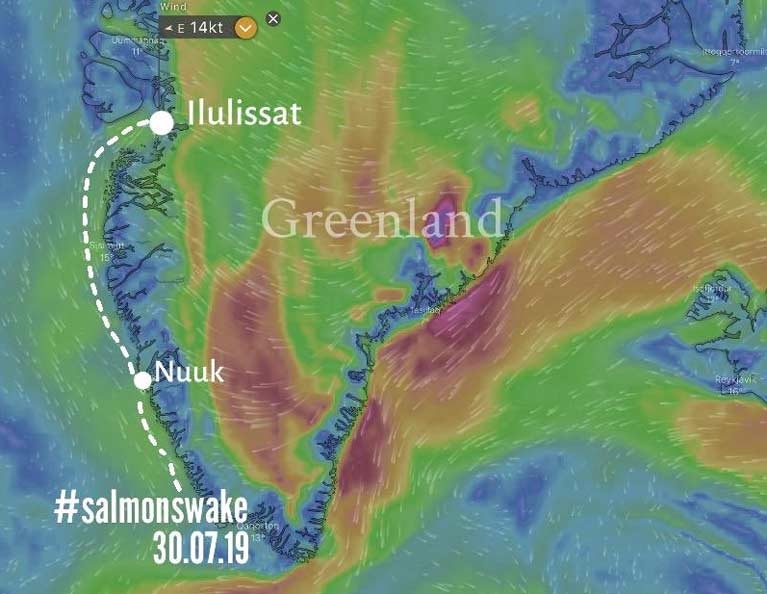 Ilulissat is the most northerly port reached by Ilen, and it will be the turning point for the Salmons Wake voyage
Ilulissat is the most northerly port reached by Ilen, and it will be the turning point for the Salmons Wake voyage
The most northerly port reached by Ilen and her current location is Ilulissat, and it is there that Project Manager Gary MacMahon – having been Ilen’s skipper for the outward passage and the work along the Greenland coast – has as planned now handed over command for the return voyage to renowned long distance and high latitudes sailor Paddy Barry, who is aboard Ilen for the entire sea-time of the Project.
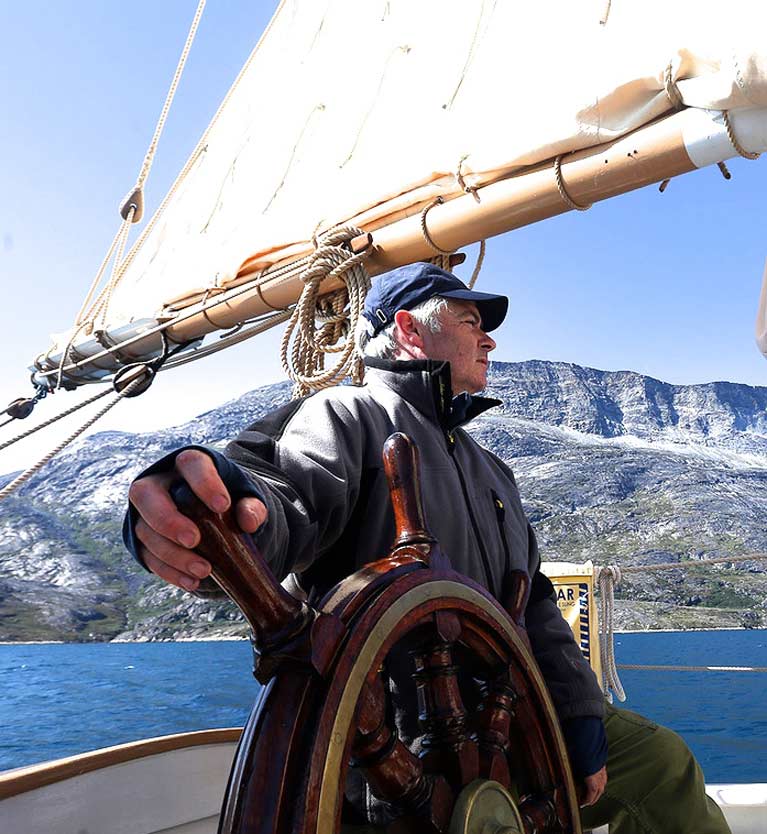 Gary Mac Mahon at the wheel of Ilen, absorbing the majesty of the Greenland coast. Photo: Deirdre Power
Gary Mac Mahon at the wheel of Ilen, absorbing the majesty of the Greenland coast. Photo: Deirdre Power
After some mountaineering in the region, Paddy will shortly be starting progress southward back to Nuuk where he and his shipmates will be joined for the main part of the return voyage by noted traditional sailors Dr Mick Brogan and Jarlarth Cunnane. It will be a busy month of August for Mick Brogan, as first he has to oversee the 40th Anniversary Cruinniu na mBad – the Gathering of the Traditional Boats - at Kinvara from 9th to 11th August.
Gary MacMahon himself has returned to Limerick in recent days to meet business requirements and also to put in hand the long work programe which will be involved in the processing of all the information that has been learned – and is still being learned – in the Salmons Wake project.
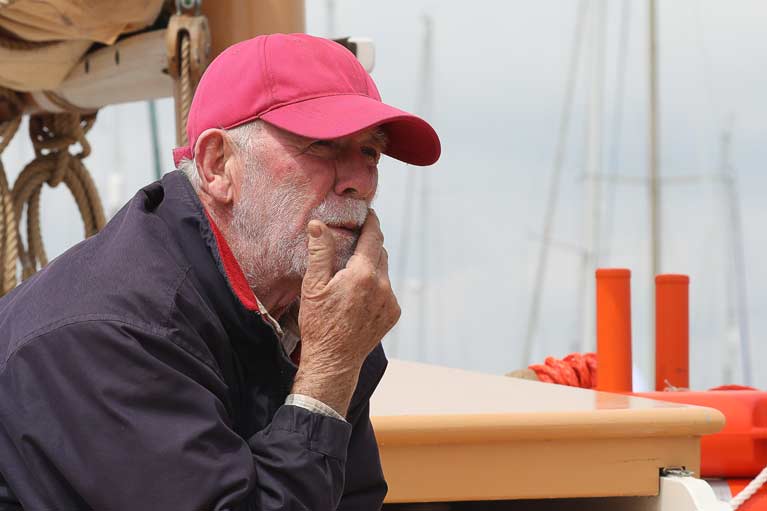 Paddy Barry, one of Ireland’s top voyagers and an expert in traditional craft, will be skippering Ilen for the homeward Transatlantic passage. Photo: Deirdre Power
Paddy Barry, one of Ireland’s top voyagers and an expert in traditional craft, will be skippering Ilen for the homeward Transatlantic passage. Photo: Deirdre Power


























